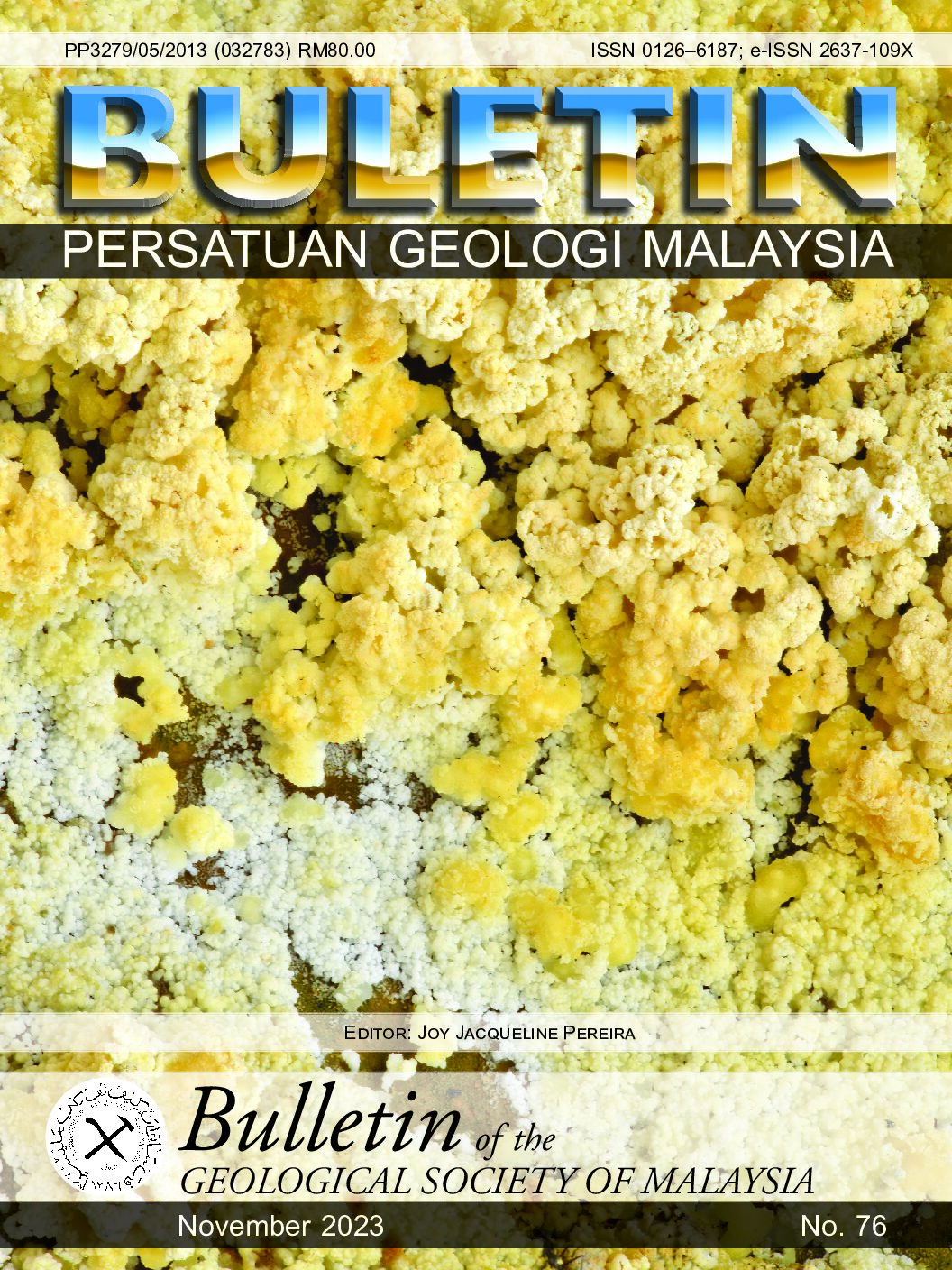
Bulletin of the Geological Society of Malaysia, Volume 76, November 2023, pp. 47 – 53
Muhammad Kadri1,2, Nordiana Mohd Muztaza1,*, Mohd Nawawi Mohd Nordin1, Muhammad Taqiuddin Zakaria1, Farid Najmi Rosli1, Mustapha Adeejo Mohammed3, Siti Zulaika4
1 Geophysics Section, School of Physics, Universiti Sains Malaysia, 11800 Pulau Pinang, Malaysia
2 Physics Department, Universitas Negeri Medan, Jl. Willem Iskandar / Pasar V, 20221 Medan, Sumatera Utara, Indonesia
3 Department of Physics, Federal University of Lafia, P.M.B 146, Maraba Akunza, Obi Road, Lafia, Nasarawa State, Nigeria
4 Faculty of Mathematic and Natural Sciences, Universitas Negeri Malang, 65145 Malang, East Java, Indonesia
*Corresponding author email address: mmnordiana@usm.my
Abstract: The manifestations of some hot springs in Siogung-Ogung, North Sumatra, Indonesia have increased speculation of likely geothermal sources. Therefore, integrated geochemical and geophysical methods were employed to identify the geothermal prospect of the area. Two-dimensional electrical resistivity and geomagnetic methods were used for the geophysical survey. The geochemical survey used three concentration measurements: geothermometer silica (SiO2), geothermometer Na-K, and geothermometer Na-K-Ca. A Wenner Schlumberger array with a 5-meter electrode spacing was used to acquire the 2-D resistivity data, which was processed using Res2Dinv software. The geomagnetic method was performed with a proton precession magnetometer, and the data were processed using Surfer to produce the magnetic residual map. The 2-D electrical resistivity results show that the area has low resistivity values (1-700 Ωm). The resistivity values from 1 to 100 Ωm could be due to the presence of hot waters in alluvium, and the resistivity values > 400 indicate andesite rock, which can function as a hot water conductor from the source. The magnetic residual map shows geomagnetic values from 150 nT to 360 nT, which infer the potentiality of geothermal within the study area. The geochemical results show that the reservoir temperature is 572 °C. Based on the integrated results, the study area has promising geothermal potential.
Keywords: Geochemical, 2-D resistivity, geomagnetic, Siogung – Ogung North Sumatra
References
Afandi, A., Lusi, N., & Subono, 2020. Estimasi Suhu Reservoir Sumber Mata Air Panas Hatuasa Ambon Dengan Metode Geokimia Berdasarkan Pengembangan Persamaan Geotermometer Empiris. International Seminar of Science and Applied Technology (ISSAT 2020), 511.
Barber, A.J., Crow, M.J & Milsom, J. 2005. Sumatra. Geology, Resources and Tectonic Evolution. Geological Society Memoir no. 31, London, Bath. 290 p.
Deng, J., Lin, W., Xing, L., & Chen, L., 2022. The Estimation of Geothermal Reservoir Temperature Based on Integrated Multicomponent Geothermometry: A Case Study in the Jizhong Depression, North China Plain. Water, 14, 2489.
Elida, S.P., Harmoko, U., & Widada, S., 2014. Interpretasi Lapisan Bawah Permukaan Di Area Panas Bumi Gunung Telomoyo, Kabupaten Semarang Menggunakan Metode Geolistrik Resistivity Konfigurasi Schlumberger. Youngster Physics Journal, 2, 119-128.
Idris, S., Syukri, M., Surbakti, M.S., Marwan, Muchlis, Rusydy, I., & Aflah, N., 2018. Analysis Of Shallow Subsurface Structure At Geothermal Area Of Ie Jue Using Resistivity Method. Jurnal Natural, 18, 17-21.
Kadri, M., & Nordiana, M.M., 2021. Geothermal Fluid Identification at Geothermal Area Sorik Marapi using 2d Resistivity Imaging. Journal of Physics: Conference Series. 1819. 012067. 10.1088/1742-6596/1819/1/012067.
Lashin, Aref & Al Arifi Nassir, 2014. Geothermal energy potential of southwestern of Saudi Arabia “exploration and possible power generation”: A case study at Al Khouba area – Jizan. Renewable and Sustainable Energy Reviews, 30(C), 771-789.
Manyoe, I.N., & Hutagalung, R., 2020. Subsurface Shallow Modelling Based on Resistivity Data in The Hot Springs Area of Libungo Geothermal, Gorontalo. Journal of Geosciences, engineering, environment and technology, 5, 75-80.
Mohammed, M.A., Saad, R., Ismail, N.A., Muhammad, S.B., Taib, A., & Saidin, M., 2019. Subsurface Soil Evaluation Using Seismic Refraction Tomography and Standard Penetration Test at Bukit Bunuh Impact Crater Area. Natural and Engineering Sciences, 4, 1-10.
Nicholson, K.N., 1993. Geothermal Fluids. Chemistry and Exploration Techniques. Springer-Verlag, Berlin, Heidelberg, New York, London, Paris, Tokyo, Hong Kong. 263 p.
Nurgalieva, N., & Yassonov, P., 2013. Magnetic susceptibility, remanent magnetization and coercivity variations along soil profile. ARPN Journal of Engineering and Applied Sciences, 8, 357-361.
Oladele, S., Ayolabi, E.A., Olobaniyi, S.B., & Dublin-Green, C.O., 2022. Investigation of geothermal potential of the Dahomey basin, Nigeria, through analysis of geomagnetic and geo-resistivity dataset. NRIAG Journal of Astronomy and Geophysics, 11, 373-386.
Santosa, B.J., Mashuri, Sutrisno, W.T., Wafi, A., Salim, R., & Armi, R., 2012. Interpretasi Metode Magnetik Untuk Penentuan Struktur Bawah Permukaan Di Sekitar Gunung Kelud Kabupaten Kediri. Jurnal Penelitian Fisika dan Aplikasinya (JPFA), 2, 7-14.
Sobirin, R., Permadi, A. N., Akbar, A. M., Wildan, D., & Supriyanto, 2017. Analysis geothermal prospect of Mt. Endut using geochemistry methods. Proceedings of the 2nd International Symposium on Current Progress in Mathematics and Sciences 2016, American Institute of Physics Inc., Article 030187.
Suharmanto, P., Fitri, A.N., & Ghaliyah, S., 2015. Indonesian Geothermal Energy Potential as Source of Alternative. KnE Energy, 1, 119-124.
Suhartono, N., 2012. Pola Sistim Panas dan Jenis Geothermal Dalam Estimasi Cadangan Daerah Kamojang. Jurnal Ilmiah MTG, 5(2), 2.
Taqiuddin, Z., Nordiana, M., & Rosli, S., 2016. Utilizing of Geophysical Method for Geothermal Exploration In Aceh Besar. International Research Journal of Engineering and Technology (IRJET), 3, 2234-2238.
Utami, Z.D., & Putra, A., 2018. The estimation of geothermal reservoir temperature using geothermometer equation in Cubadak area, Pasaman regency. Journal of Physics: Conference Series,1185, 1-5.
Zhang, W., Wang, G., Xing, L., Li, T., & Zhao, J., 2018. Geochemical response of deep geothermal processes in the Litang region, Western Sichuan. Energy Exploration & Exploitation, 37(2). https://doi/10.1177/0144598718812550.
Manuscript received 3 March 2023;
Received in revised form 1 May 2023;
Accepted 17 July 2023
Available online 29 November 2023
DOI: https://doi.org/10.7186/bgsm76202304
0126-6187; 2637-109X / Published by the Geological Society of Malaysia.
© 2023 by the Author(s). This is an open access article distributed under the terms of the Creative Commons Attribution (CC-BY) License 4.0.